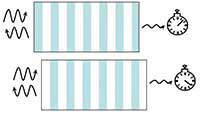Mar 14 2008
Using a system that can compare the travel times of two photons with sub-femtosecond precision, scientists at the Joint Quantum Institute (a partnership of the National Institute of Standards and Technology (NIST) and the University of Maryland) and Georgetown University have found a remarkably large difference in the time it takes photons to pass through nearly identical stacks of materials with different arrangements of refractive layers. The technique, described at the annual March Meeting of the American Physical Society, ultimately could provide an empirical answer to a long-standing puzzle over how fast light crosses narrow gaps that do not permit the passage of conventional electromagnetic waves.
 Diagram of two stack configurations with odd numbers of layers. Blue layers have a high index of refraction, white layers a low. The stacks are nearly identical with the exception of where the extra layer is deposited.
Diagram of two stack configurations with odd numbers of layers. Blue layers have a high index of refraction, white layers a low. The stacks are nearly identical with the exception of where the extra layer is deposited.
Alan Migdall and his colleagues set up a race course using “correlated” pairs of photons—indistinguishable photons created simultaneously. One photon passes through the sample to be tested while the other is directed along a path of adjustable length. The finish line is a so-called Hong-Ou-Mandel interferometer, a beamsplitter that the photons strike obliquely. Individual photons have a fifty-fifty chance of either passing through the beamsplitter or bouncing off it, but when two correlated photons arrive simultaneously, the rules of physics say they both must come out in the same direction.
As a result, this arrangement can detect when the first photon has taken exactly as long to get through the test object as the second photon did to traverse its path. This changes the difficult problem of measuring extraordinarily short intervals of time into the easier one of measuring distances. Through refinements to the design of their interferometer, Migdall and his colleagues can measure simultaneity with sub-femtosecond precision.
The team measured photon transit times through stacks consisting of alternating layers of material with high and low refractive index—the kind of arrangement that makes a light beam seem to bend as it crosses the boundary.
The new experiments verify the theoretical prediction that photon transit time will vary significantly depending on how you arrange the stack. Migdall and his team found that a photon takes about 20 femtoseconds less to get through a stack of 31 layers, totaling a few microns across, when the stack begins and ends with high refractive index layers rather than the opposite. The shorter time delay is apparently superluminal i.e., shorter than the time needed for light in a vacuum to traverse the same distance. (This is possible because of a loophole in the speed-of-light limit that says that some wave-related phenomena can propagate superluminally if they do not transmit equivalent information faster than the speed of light.)
The team hopes to move on to a more perplexing case. Light striking the boundary between two refractive materials at a sufficiently shallow angle glances off completely as a reflection rather than passing through, but also creates a decaying field known as an evanescent wave on the other side of the boundary. This evanescent wave can reach across a narrow gap and strike up a new light wave in an adjacent medium. Theorists have presented discrepant calculations of how long light takes to traverse such a gap, but Migdall says the new system should be precise enough to measure such transits directly.